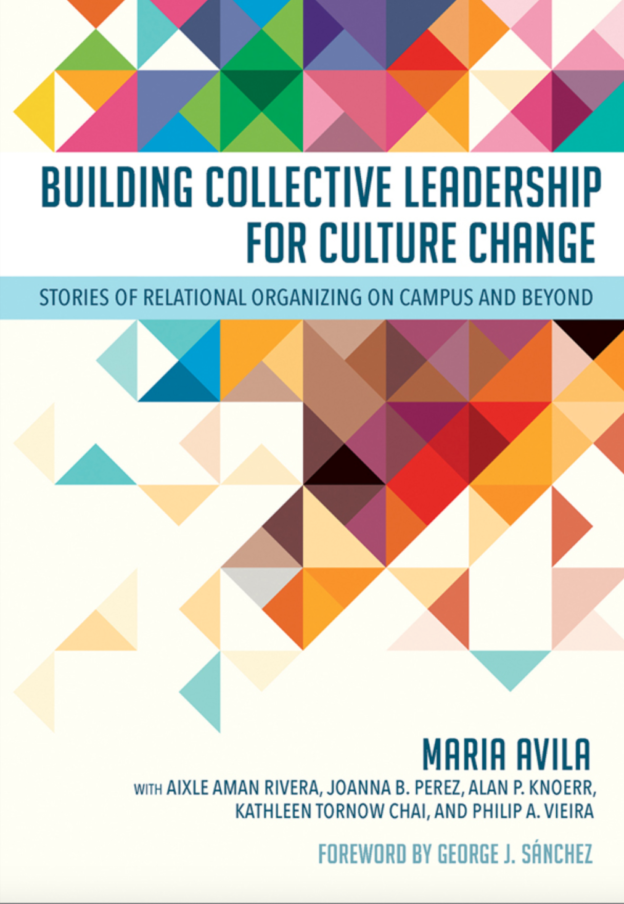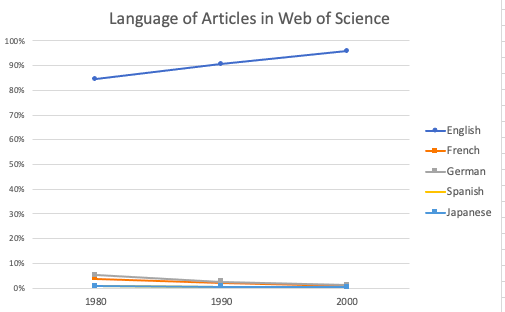- Facebook27
- Twitter1
- Total 28
Maria Avila is a great community organizer in the tradition of the Industrial Areas Foundation. I often assign her writing to introduce students to principles and strategies for organizing. For instance, this fall, our undergraduates read chapters of her Transformative Civic Engagement Through Community Organizing.
Her latest book is Building Collective Leadership for Culture Change: Stories of Relational Organizing on Campus and Beyond (Cornell University Press, 2023), which she wrote with contributions from Aixle Aman Rivera, Joanna B. Perez, Alan P. Knoerr, Kathleen Tornow Chai, and Philip A. Vieira and a foreword by George J. Sánchez.
This book reflects Maria’s turn to organizing in and from academia. After working in organizations in Chicago and Ciudad Juarez and organizing intensively in neighborhoods in Los Angeles and Albuquerque, she earned a PhD and held positions at Cal State Dominguez Hills (CSUDH) and Occidental College. She says she has used “parts of [the IAF organizing] model to guide my work” in academic jobs “and throughout my doctoral and postdoctoral research” (p. 34). Building Collective Leadership is about being “a civically engaged scholar and organizer,” one who “work[s] with others to create a more democratic, collaborative culture in academic institutions where I work, and in the communities with which I partner (p. 52).”
The model that Maria employs has five very practical components (pp. 38-9).
She starts by “conducting relational one-on-one meetings with people I think might be interested in my work, to learn about people’s self-interest through sharing personal and/or professional stories.”
One-on-one meetings are fundamental to the IAF approach and have a particular character. They are two-way conversations that explore connections between the discussants’ personal values and interests and shared or public issues. These meetings create relationships that are assets for public work. They are not simply friendly and private, nor are they transactional–trying to get another person to do or agree to something. They are the first step in deciding together what we should do.
Maria then invites people who have resonated to her work to join “projects I am working on, based on their interests.” She creates spaces where these people can share their “personal and professional stories,” make and execute plans, and reflect. She educates others about the organizing methods that she has learned and has helped to develop, and she organizes discussions (based on readings) about relevant methods, such as “participatory research in action, narrative inquiry, community organizing, and civically engaged scholarship.”
Building Collective Leadership describes such processes at generally increasing scales. Chapters 1 and 2 are mostly about Maria’s own background and research. In chapter 3, she and her colleagues Kathleen Tornow Chai and Enrique Ortega describe one-on-one interviews and intensive group discussions within CSUDH’s College of Health, Human Services, and Nursing, which shifted the culture of that academic unit.
In chapter 4, Aixle Aman Rivera and Ray López-Chang discuss a partnership involving Maria and a Los Angeles Unified School Board district that changed its office culture and daily practices. In chapter 5, the focus shifts to regional organizing across Southern California and a project to build an intercollegiate chapter of the national network known as Imagining America, which emphasizes the humanities and arts. Chapter 6 describes a particular Imagining America research project that connected CSUDH to student-led and community-based groups. Chapter 7 discusses a reform of the curriculum at CSUDH, when civic engagement was built into the General Education requirements. Importantly, this effort involved community partners from the start.
The book reflects many voices, sometimes in the form of co-authored narratives and sometimes as explicit dialogues among participants. Quite a few of the contributors use the opportunity to criticize prevailing norms and systems of US higher education. For example, CSUDH professor Joanna B. Perez contrasts her “parents’ teachings of humility, community, and service” to “the egocentric and competitive nature of academia” (p. 188). Maria aspires to act “in a relational and hopefully more humane way than what the competitive and siloed academic culture tends to allow” (p. 223).
These critical reactions fuel the desire for change. Speaking for myself, I think that higher education deserves criticism. But I also observe that people who effectively use relational organizing methods within institutions, such as universities or government agencies, often demonstrate underlying care, affection, and loyalty for those institutions and their people (including their leaders). In the terms defined by Albert O. Hirschman, they opt to use “voice” rather than “exit” because they are loyal. The missions, histories, and particular roles of entities like a Cal. State public university inspire them.
I say this because I think that community organizing is effective when there is some alignment between the organizer and the institution. When that is completely absent, it is better to organize outside the institution.
If you are a socialist, you should not take a job at a bank, thinking that it has a lot of money and you can organize from within to distribute the money to the people. You will be endlessly frustrated. You would be better off organizing pressure on the bank from outside–from governments, unions, or social movements–or possibly trying to build some kind of cooperative alternative to a bank that can compete with it effectively. Likewise, if you are a true libertarian, you should probably not become a civil servant, unless you are willing to treat your job as Ron Swanson does and gain your personal satisfaction elsewhere.
(To complicate the advice of the previous paragraph, I acknowledge that you might be a little bit of a socialist or a mild libertarian and still think that you can be helpful working for a bank or a government program. Or you might feel you have no choice: there is nowhere to work except at organizations you despise. But in the latter case, you should try to get out of this bind as soon as possible.)
If you do basically appreciate an institution, such as a university, then organizing within it will sometimes be frustrating and will sometimes fail, but it can be deeply satisfying. You will be able to use mission statements and official policies as resources, since you want to reduce the gap between public promises and actual performance. You will find some programs, funding streams, offices, and positions that are useful for your cause. You should be able to identify allies, since other employees (and students) will be drawn to the organization for similar reasons as yours. One-on-one interviews can reveal such shared motivations. If you’re fortunate, your work will be rewarded by colleagues and even supervisors, since you are fundamentally committed to their common purpose. I think it’s OK to acknowledge your love for an institution that you critically engage.
To be an effective organizer, you do not need positional power: the ability to tell subordinates what to do. Aman Rivera and López-Chang note that their purported positional power as city officials was often illusory, anyway (p. 109). (On the other hand, if you happen to hold a high office, Maria’s methods can still be useful for you). You do need hope, relationships, and good strategies. Building Collective Leadership exemplifies all three.

